A seventy-year-old couple from Hola Prystan, despite their health issues, opted to evacuate with just a single bag and their dachshund. Meanwhile, twenty-year-old Tiya from Makiivka waited until she turned eighteen before leaving with her cat, while her pro-Russian parents stayed behind in the occupied territories. The organisation Helping to Leave, which aids those from occupied regions and deportees in returning to Ukraine, spoke to The Ukrainian Week about the logistics of evacuation through the Kolotylivka-Pokrovka and Mokrany-Domanove humanitarian corridors and the requirements for a successful operation.
***
Sewing blue-yellow flags in the Russian occupation
In early June, seventy-year-old Pylyp Bronislavovych and his wife, Olha Pavlivna, evacuated Hola Prystan in the Kherson region, leaving behind only a single bag of belongings and their dachshund. Their home had been ravaged by shelling and flooding. Pylyp, in need of an expensive hip replacement, and Olha, battling cancer, had resisted evacuation at their children’s urging, clinging to the hope that the Ukrainian Armed Forces might liberate Hola Prystan. Even under occupation, they continued to display blue and yellow flags in anticipation of Ukrainian forces.
“Now, at least there are no Russian bombs over our heads, and my husband is on the surgery waiting list. We’re hopeful it will happen by the end of the year. He had surgery on one leg in 2021, and now he’s preparing for the second,” says Olha Pavlivna.
The situation deteriorated further when the Kakhovka Hydroelectric Power Plant was blown up, flooding their home and submerging it for three days. Despite the severe damage, Russian forces continued to loot Hola Prystan, seizing even the water-damaged remnants of residents’ belongings.
Pylyp Bronislavovych and Olha Pavlivna once thrived in Hola Prystan, starting with a modest market stall and eventually acquiring and refurbishing the local river station, which they rented out for additional income. Now, their property is devastated by both water and fire.
“They [Russians – ed.] burned everything: entire forests are ablaze, two cemeteries have been reduced to ashes, and our town, Hola Prystan, is engulfed in flames,” says Olha Pavlivna. “Now, only pensioners remain, with nowhere else to go.”
The couple has since relocated to Kamianets-Podilskyi. They are actively supporting the Ukrainian military and are currently striving to secure funds for their upcoming rent.
“I’ve cried more in these past two years than in my entire life,” Olha Pavlivna confides. “We hope to return to our peaceful life soon. For two and a half years, we held out hope, even sewing Ukrainian flags while under occupation. Now, we contribute as we can—our whole family is involved in weaving camouflage nets. If we cannot weave, we take the fabric home and cut it into strips.”
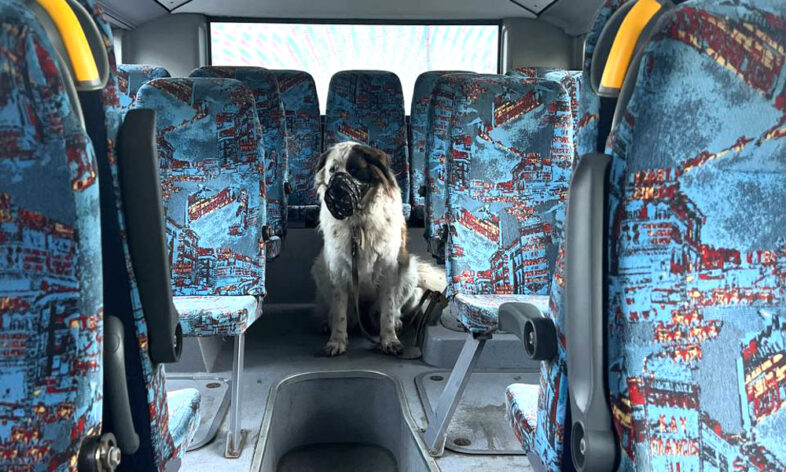
How to evacuate without a passport
You can access free evacuation assistance from Helping to Leave via their Telegram bot and hotline. “The primary language for communication is Russian, as people may encounter issues if their phones are checked by the Russians,” explains Olena Hubanova, who coordinates evacuations from the Sumy humanitarian corridor and the liberated areas of the Kharkiv region. She advises that even those who plan to manage their own evacuation should consult with volunteers. They can offer crucial advice on preparation and what to anticipate.
It is possible to evacuate without a Ukrainian passport. “Sometimes, people are stopped by Russian forces—particularly in the Kherson region—who demand to see their passports and may destroy them,” says Hubanova. In such situations, Ukraine can issue a temporary certificate of citizenship for returning to the country. However, if evacuees have any form of identification that proves their Ukrainian citizenship, such as a photocopy, they can still return to Ukraine without a passport or special certificate.
“I evacuated with just my Ukrainian birth certificate and a so-called ‘DPR’ passport,” says Tiya, a twenty-year-old from Makiivka.
“It became untenable to remain in the occupied territory without a Russian passport. The Russians would come to your door, threatening you, ‘Take the passport, don’t you understand?’—while pointing a gun at you. Some kid gets handed a weapon and starts acting like a dictator! They get drunk, begin firing indiscriminately, and create chaos,” Pylyp Bronislavovych recalls.
He and his wife, despite their initial resistance, were eventually compelled to accept the Russian passports due to the dire circumstances. The couple managed to conceal their Ukrainian documents among their belongings and used them to navigate the corridor through Belarus.
Preparation for evacuation
At the outset of the evacuation process, volunteers carefully assess both the physical and psychological state of each individual. They gather details about any existing health issues and evaluate the person’s ability to walk or sit unaided, as well as their capacity to travel independently. If needed, explains Olena Hubanova, the organisation provides wheelchairs and arranges for companions within the evacuation group to assist those with limited mobility throughout the journey.
The humanitarian corridors for crossing into Ukrainian territory are located at two points: Kolotylivka — Pokrovka (Sumy region, Russia-Ukraine) and Mokrany — Domanove (Volyn region, Belarus-Ukraine). These corridors function differently from regular border crossings; they are exclusively for Ukrainian citizens and facilitate travel in one direction only. As with regular borders, there is a strict limit on the amount of cash that can be carried, capped at ten thousand dollars.
“To start, we need detailed information about both the available documents and the individual’s condition,” explains Olena Hubanova. “For instance, if someone has limited mobility and carries both Ukrainian and Russian documents, we plan one route. If they possess only Ukrainian documents, we opt for a different route. Our priority is always to ensure the entire journey is as safe as possible, maintaining constant communication and considering all available options.”
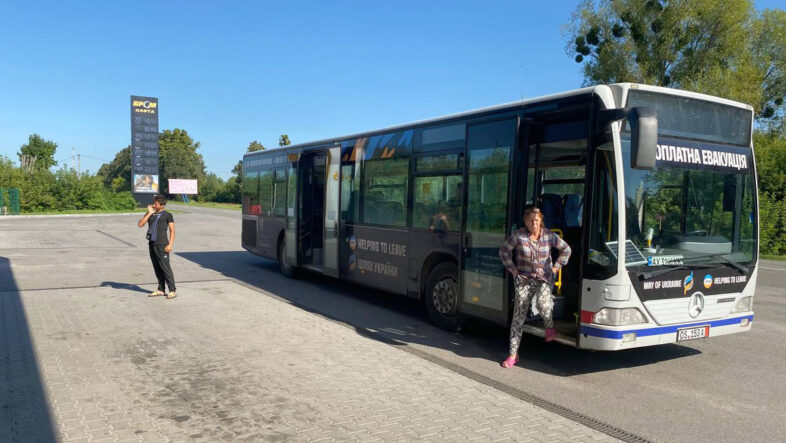
Pylyp Bronislavovych recounts their evacuation journey: “They picked us up right from our building, along with our belongings and our dog. At the Ukraine-Russia border in the Rostov region, we were briefly stopped. The Russian officials glanced at us, said nothing, and let us proceed. The following day, we were transported from Rostov to another city and then on to Belarus, where we spent the night. The next leg of our journey took us to Mokrany. There, I was provided with a wheelchair to navigate the corridor. We are immensely grateful to the Ukrainian soldiers who met us, assisting me over every ditch and obstacle in that wheelchair.”
From Domanove, the couple was transported to Kovel and spent the night in a church. The following day, they were put on a bus to Kamianets-Podilskyi, where they reunited with their sons and their families. However, Olha Pavlivna notes that their new life is fraught with difficulties: their pension is insufficient, one-time payments have ceased, humanitarian aid is infrequent, and they still face the challenge of finding a rental apartment.
Olena Hubanova highlights the importance of thorough preparation: “It’s crucial for volunteers to determine if there are any family connections to Ukrainian officials or service members, as well as if the individual has ever been detained. The Russians may already have such information. Once we fully understand the person’s situation, we provide comprehensive support. This includes preparing them emotionally for potential questions, guiding them on how to respond, and advising them on what to expect. We ensure that we won’t abandon them.”
She adds that preparation for evacuation can vary significantly: “It typically takes 2–3 days if there are no complicating factors, such as relatives in the occupiers’ databases. However, in some cases, it can extend to 2–3 months.”
“We’ve encountered cases where people attempted to conceal the fact that their relatives were listed in the Russian databases,” Olena Hubanova warns. “The Russians can detain and blackmail individuals based on this information.”
“I decided to evacuate from the city of Makiivka, which has been occupied since 2014. It was a long and difficult decision, and I prepared for it for six months. I had limited funds, and the huge problem was that I was travelling with a cat that wasn’t microchipped or vaccinated. When I left, I was 19; now I’m 20. I depended on my parents for a while because when the full-scale invasion began, I was still a minor. My parents are pro-Russian and had no desire to leave, so I went alone,” shares twenty-year-old Tiya (a pseudonym).
The way out
The journey typically spans 2 to 5 days, primarily navigating the Kolotylivka-Pokrovka corridor, according to the coordinator. This evacuation service is entirely free of charge, with volunteers covering all aspects, including transportation, accommodation during departure, food, hygiene supplies, and medications.
“On the ground in occupied territories and Russia, we do not have our own volunteers. Instead, we rely on public transport for the journey. We ensure the person has overnight accommodations, provide meals, arrange necessary medications, and, if required, hire a caregiver,” explains Olena Hubanova.
Once in Belgorod, evacuees are transported to Kolotylivka. “We maintain constant contact throughout the process. Our team in Sumy is ready to receive the evacuees. If there are additional needs, such as mobility issues, health concerns, or mental health support, we coordinate with the Red Cross. The Red Cross assists in the grey zone,” Hubanova adds. She notes that this arrangement with the Red Cross began this spring. Previously, evacuees had to traverse a two-kilometre stretch of gravel in the grey zone on foot.
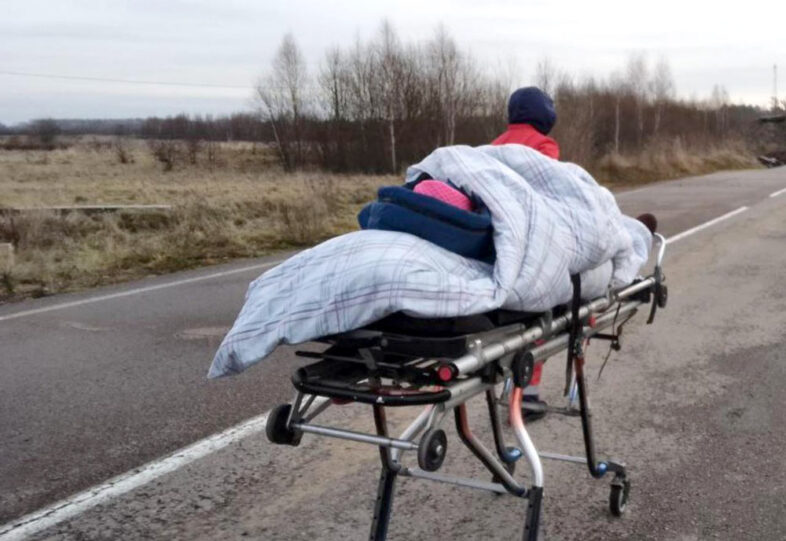
Photo: Mokrany – Domove, the journey.
“In the depths of winter, with temperatures plummeting to minus twenty and possibly even lower in the open fields, we faced a challenging situation. An elderly woman, nearly blind and travelling alone, was struggling to navigate the harsh conditions. At the last moment, a nineteen-year-old girl from Donetsk appeared, offering to help. She had a cat and a few belongings, while the elderly woman also had numerous items. With darkness falling, visibility was poor—just a narrow path in the field, compounded by heavy snow and biting cold. We grew increasingly concerned as they seemed to be delayed. They had traversed the grey zone for nearly seven hours. At one point, the girl called for assistance. Our team used a thermal imaging device to locate them, but despite spotting them, we couldn’t physically reach them. Nevertheless, the women managed to complete the journey,” recounts Olena Hubanova, noting that it was impossible to assist them directly.
“Following the death of a woman during the crossing and a young man from the group carrying her body to Ukraine, the Russians eventually permitted the Red Cross to provide aid in the grey zone,” adds Hubanova. Now, the Red Cross is able to operate within this area.
“This is why we inquire about a person’s walking ability. If they can manage at least 300–500 meters, the Red Cross will meet them at that point. For those who cannot walk but can sit, we provide wheelchairs and arrange for someone in the group to assist with pushing,” Hubanova explains. Volunteers maintain continuous contact with the families of those being evacuated.
According to Olena Hubanova, though fraught with difficulty and stress, the evacuation journey forges a sense of solidarity among people. “People do help one another, though the circumstances can vary significantly. When the Russians destroyed the Kakhovka Hydroelectric Plant, the number of people needing evacuation surged. We were managing groups of up to seventy per departure, with daily evacuations involving between 50 and 70 people. In one group from Oleshky and Holaya Prystan, there were many elderly individuals and those with limited mobility. One elderly couple, likely over 75 years old, had the wife transported in a wheelchair. Although she could walk, it was extremely taxing for her. Accompanying them was a thirteen-year-old Newfoundland dog. It was August, blisteringly hot, and we were anxious for the ageing dog, which weighed around 90 kilograms.
There was also a woman in a wheelchair with limited mobility. One man from the group initially took on the task of pushing her wheelchair, but eventually, he abandoned her. Consequently, the elderly man with the dog ended up pushing both his wife and the other woman in the wheelchair,” recounts Hubanova.
“I travelled from Donetsk by bus to Rostov, then to Belgorod, and finally to the checkpoint. Although the journey was relatively calm and free from inspections, it was psychologically taxing. I ended up separated from the group during the crossing because I had a lot of belongings. Fortunately, other members of the group noticed my slow progress and came back to help me. They fetched me from the grey zone, assisted with my belongings, and even took care of my cat,” recounts Tiya from Makiivka.
Once they cross the humanitarian corridor, border guards take evacuees to Pokrovka for an initial inspection of their documents and possessions. They are then transported to Sumy, where a more thorough check is conducted. Following this, volunteers escort them to the compact living area (CLA) in Sumy, where they spend the night and make plans for their next steps.
Evacuation routes
In Sumy, volunteers assist evacuees in planning their next steps. They first inquire about the evacuees’ intended destinations and then register them for UN payments of 10,800 UAH per person. These funds are expected to be disbursed within one to three months. Payments can be processed even if a Ukrainian passport has not yet been issued; a certificate of application for passport renewal is sufficient.
Evacuees have three main routes within Ukraine: a train from Sumy to Kyiv, a bus route from Sumy to Poltava to Dnipro, and a bus from Sumy to Kharkiv. Additionally, there is a shelter in the village of Zernove in the Kharkiv region.
“If people are uncertain about their next destination, they can stay at the shelter in Zernove for up to three months. This provides time to sort out their future plans, find housing or employment, and address any document issues. During this period, we offer assistance with document restoration, provide consultations, and help with transportation to the city. Our volunteers also aid in navigating state institutions such as banks, social services, and administrative service centres. If medical attention is required, we arrange hospital visits and support. The shelter is equipped with facilities for those with limited mobility, caregivers, psychologists, doctors, and even offers toys for children, generators, and accommodations for pets,” explains Olena Hubanova.
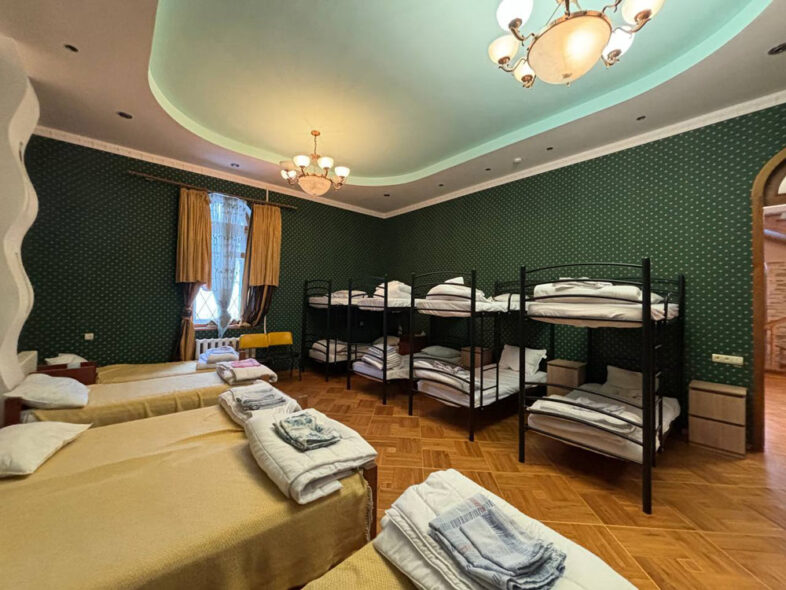
Tiya adds, “I spent a month at the shelter in Zernove before volunteers helped me find an apartment and a job. Living under the Ukrainian flag feels far better than under the Russian one. If there’s still a home left under the Russian flag, it’s better to leave while there’s still a chance, as the opportunity might be quickly cut off.”
Currently, the organisation is also evacuating from de-occupied communities in Kharkiv Oblast and compiling lists of those deported from Vovchansk and Lypetske communities.
“We have a list of people who were in Lukyantsi collected by locals. Of course, it is incomplete. Mostly, these are elderly people who were taken to Russia, and their relatives know where they are. They should contact us. We will bring these people back. We have already conducted several evacuations of deported residents from Vovchansk and Lypetske communities,” invites Olena Hubanova, adding that the evacuation is free of charge and issues with documents can also be resolved.
Adaptation
The primary obstacle, according to the coordinator, is fear. “I come from a temporarily occupied area myself, though my time under occupation was relatively brief, about a year. However, some people have been living in these conditions for two and a half or even ten years. It’s as if they are entrenched in their own routines, going to familiar shops, but no longer feel truly at home. They worry that their new environment will be just as unsettling. When we discuss evacuation with them, they often ask what to bring. We recommend taking only essential items—everything else will be provided by organisations in Ukraine. We do suggest bringing something personal, like photos or a child’s blanket, to offer a touch of familiarity,” explains Olena Hubanova.
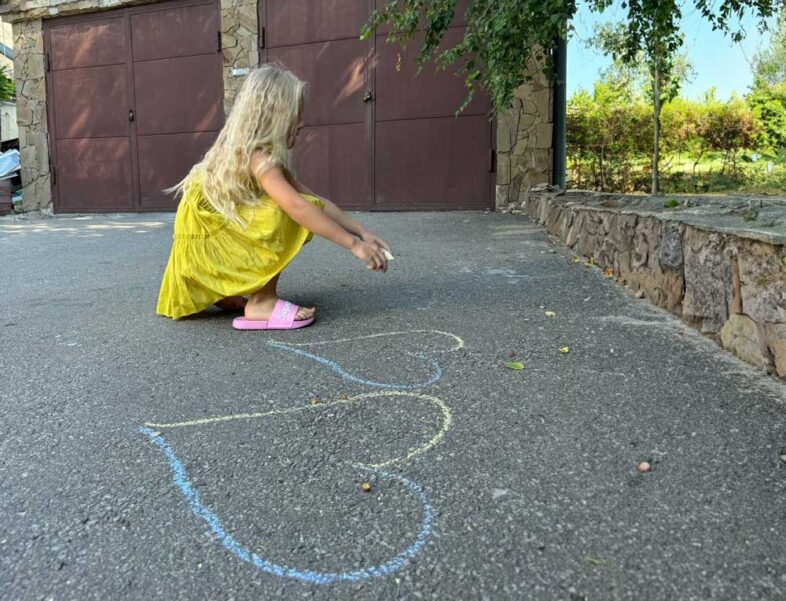
“If someone wants to find work, they can contact us directly. We will discuss their situation and then liaise with local administrations in their new region to facilitate their integration. For instance, we recently helped a man who had spent his life working on a farm and wanted to continue working after evacuation, but his health had deteriorated. We found him a suitable job in the Odesa region, arranged housing, and provided him with everything he needed. He arrived with just a single bag,” adds Olena Hubanova, noting that local communities are keen to welcome new residents and offer employment opportunities.
After evacuation, volunteers continue to provide support, addressing issues related to employment, housing, and documentation. “When we realise that someone is uncertain about their next steps, we follow up with them after a week or two. By then, they have usually had time to assess their situation and identify any problems. That’s when we step in. They may need humanitarian aid, assistance with housing, help with paperwork, or perhaps wish to relocate because their current situation isn’t working out. In these cases, we don’t merely hand out a phone number; we manage each case personally. We contact our partners, oversee the situation, and ensure it is resolved,” explains Olena Hubanova.
***
From January to July 2024, the Helping to Leave organisation evacuated 1,208 individuals. In May 2024, with the onset of a Russian offensive in northern Kharkiv, the front lines became highly volatile, and some areas were re-occupied. The organisation received requests for evacuation from 194 people in May who sought to escape newly re-occupied regions.
Since its inception in February 2022, the organisation has provided assistance to approximately 45,000 people, offering financial aid, humanitarian support, psychological counselling, and direct evacuation services.

